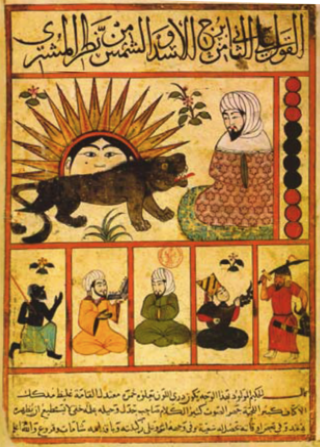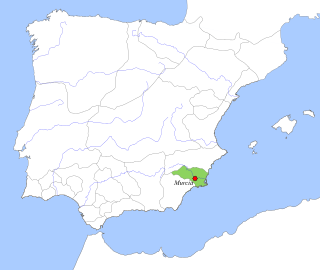Related Research Articles
Zayd ibn ʿAlī, also spelled Zaid, was the son of Ali ibn al-Husayn Zayn al-Abidin, and great-grandson of Ali ibn Abi Talib. He led an unsuccessful revolt against the Umayyad Caliphate, in which he died. The event gave rise to the Zaydiyya sect of Shia Islam, which holds him as the next Imam after his father Ali ibn al-Husayn Zayn al-Abidin. Zayd ibn Ali is also seen as a major religious figure by many Sunnis and was supported by the prominent Sunni jurist, Abu Hanifa, who issued a fatwa in support of Zayd against the Umayyads.

Abu Ma‘shar al-Balkhi, Latinized as Albumasar, was an early Persian Muslim astrologer, thought to be the greatest astrologer of the Abbasid court in Baghdad. While he was not a major innovator, his practical manuals for training astrologers profoundly influenced Muslim intellectual history and, through translations, that of western Europe and Byzantium.
Abu Jafar Muhammad ibn Husayn Khazin, also called Al-Khazin, was an Iranian Muslim astronomer and mathematician from Khorasan. He worked on both astronomy and number theory.
Ahmad ibn 'Abdallah al-Marwazi, known as Habash al-Hasib was a Persian astronomer, geographer, and mathematician from Merv in Khorasan, who was the first to describe the trigonometric ratios tangent, and cotangent. Al-Biruni who cited Habash in his work, expanded his astronomical tables.
Pope Peter V of Alexandria was the 83rd Pope of Alexandria and Patriarch of the See of St. Mark from 1340 to 1348.

Alid dynasties of northern Iran or Alavids. In the 9th–10th centuries, the northern Iranian regions of Tabaristan, Daylam and Gilan, sandwiched between the Caspian Sea and the Alborz range, came under the rule of a number of Arab Alid dynasties, espousing the Zaydi branch of Shia Islam.
Occultation in Shia Islam refers to the eschatological belief that the Mahdi, a descendant of the Islamic prophet Muhammad, has already been born and he was subsequently concealed, but he will reemerge and he will establish justice and peace on earth at the end of time. The signs of his (re)appearance are largely common in Shia and Sunni, , and the belief in the eschatological Mahdi remains popular among all Muslims, possibly owing to numerous traditions to this effect in canonical Sunni and Shia sources.
Abu Talib ibn Abd al-Muttalib was the leader of Banu Hashim, a clan of the Qurayshi tribe of Mecca in the Hejazi region of the Arabian Peninsula. He being the brother of Abdullah, the father of the Islamic Prophet Muhammad, was his uncle and father of Ali. After the death of his father Abd al-Muttalib ibn Hashim ibn Abd Manaf, he inherited this position as tribal chieftain, and the offices of Siqaya and Rifada. He was well-respected in Mecca.

The Taifa of Murcia was an Arab taifa of medieval Al-Andalus, in what is now southern Spain. It became independent as a taifa centered on the Moorish city of Murcia after the fall of the Umayyad Caliphate of Córdoba. The Moorish Taifa of Murcia included Albacete and part of Almería as well.
Abū Jaʿfar Aḥmad ibn ʿAbd al-Malik Ibn Saʿīd is best known as a poet, and lover of Ḥafṣa bint al-Ḥājj ar-Rakūniyya.
The Banu Kilab was an Arab tribe in the western Najd where they controlled the horse-breeding pastures of Dariyya from the mid-6th century until at least the mid-9th century. The tribe was divided into ten branches, the most prominent being the Ja'far, Abu Bakr, Amr, Dibab and Abd Allah. The Ja'far led the Kilab and its parent tribe of Banu Amir, and, at times, the larger Hawazin tribal confederation from the time of the Kilab's entry into the historical record, c. 550, until the advent of Islam, c. 630, except for two occasions when the larger Abu Bakr was at the helm. Under the Ja'far's leadership the Kilab defeated rival tribes and the Lakhmid kings and eventually became guards of the Lakhmid caravans to the annual fair in the Hejaz. The killing of a Ja'far chief as he escorted one such caravan led to the Fijar War between the Hawazin and the Quraysh of Mecca.
Abu Jaʿfar An-Nahhas was an Egyptian Muslim scholar of grammar and Qur'anic exegete during the 10th-century Abbasid period. His full name was Abū Jaʿfar Ahmad Ibn Muhammad Ibn Ismail Ibn Yūnus al-Murādi, surnamed an-Nahhās "copper-worker".
Abu Muhammad Yahya ibn Aktham was a ninth century Arab Islamic jurist. He twice served as the chief judge of the Abbasid Caliphate, from ca. 825 to 833 and 851 to 854.
Abu Ruwaym Ibn ʽAbd ar-Rahman Ibn Abi Naʽim al-Laythi (70-169AH), better known as Nafiʽ al-Madani, was one of the transmitters of the seven canonical Qira'at, or methods of reciting the Qur'an. Outside of Egypt, his method of Qur'an recitation is the most popular in Africa in general, and his chain of narration returning to the companions of the Islamic prophet Muhammad is well-attested.
ʿĀmir ibn al-Ṭufayl ibn Mālik ibn Jaʿfar was a chieftain of the Banu 'Amir and a poet. He belonged to the Banu 'Amir's preeminent household, the Ja'far ibn Kilab. He succeeded his father as head of the tribe in its wars with the Khath'am tribe until his injuries and battlefield setbacks forced him to step down. He was reinstated as leader following the death of his uncle Abu Bara.
Tāj al-Ma‘ālī Abū ‘Abd Allāh Shukr ibn Abī al-Futūḥ al-Ḥasan ibn Ja‘far al-Ḥasanī, also named Muhammad, was the fourth and last Musawid Emir of Mecca. He inherited the throne after the death of his father Abu al-Futuh in 400 AH (1010). During his reign, he declared war against the Husaynid Sharifate in Medina and brought both holy cities under his control. He died in Ramadan 453 AH, He was deposed by the Sulaymanids in 403 AH (1012) AD by Abu Tayeb Daoud bin Abdul Rahman. He had one daughter; she married Abu Hashim Muhammad ibn Ja'far. Since he had no son, one of his slaves succeeded him as Emir, but the Emirate was soon captured by sharifs of the Sulaymanid dynasty. In late 455 AH (1063) Ali al-Sulayhi captured Mecca and appointed Abu Hashim Muhammad ibn Ja'far as Emir.
References
- ↑ "Abu Ja'far ibn Habash". Encyclopedia Islamica. CGIE. Retrieved 27 March 2017.